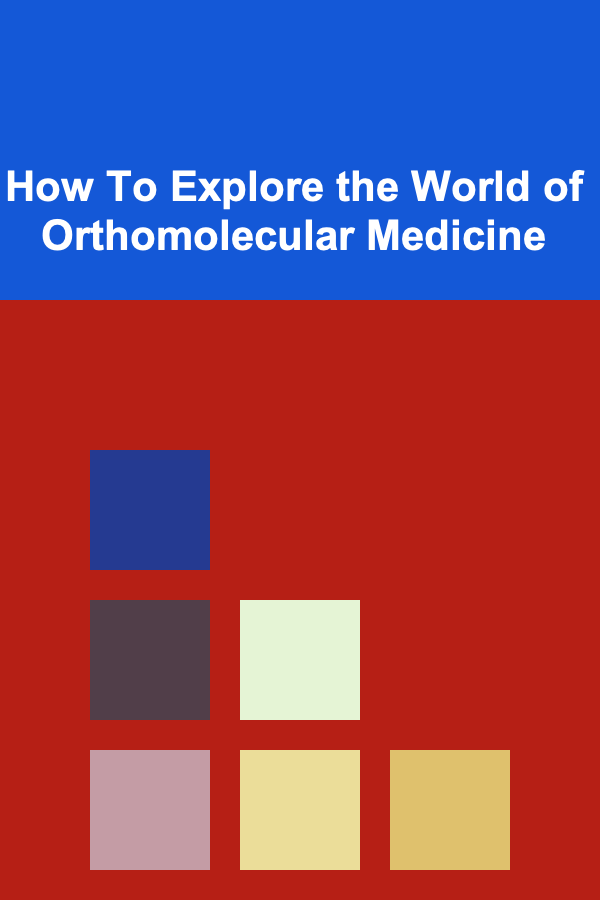
How To Explore the World of Orthomolecular Medicine
ebook include PDF & Audio bundle (Micro Guide)
$12.99$5.99
Limited Time Offer! Order within the next:

Orthomolecular medicine is an innovative approach to health and healing that emphasizes the use of naturally occurring substances in the body to maintain or restore optimal health. The term "orthomolecular" comes from the Greek word "ortho," meaning "correct" or "right," and "molecule," referring to the smallest unit of a chemical compound. Coined by Nobel Prize-winning chemist Linus Pauling in the 1960s, orthomolecular medicine focuses on optimizing the concentration of substances such as vitamins, minerals, amino acids, and fatty acids in the body to prevent or treat illness.
In this article, we will explore orthomolecular medicine's history, principles, applications, controversies, and how to delve deeper into this fascinating field.
The History and Origins of Orthomolecular Medicine
The origins of orthomolecular medicine can be traced back to the work of Linus Pauling, one of the most renowned chemists of the 20th century. While Pauling is most famous for his work on the chemical bond and his advocacy for the importance of vitamin C, his interest in orthomolecular medicine was a culmination of his broader efforts to understand how to maintain and improve human health.
In the early 1960s, Pauling began investigating the role of vitamins and other nutrients in preventing and treating diseases, particularly chronic conditions. His groundbreaking work focused on vitamin C, which he believed had powerful antioxidant and immune-boosting properties. Pauling's research led to the publication of his book Vitamin C and the Common Cold (1970), where he argued that high doses of vitamin C could prevent colds and improve overall immune function.
While Pauling's advocacy of high-dose vitamin C initially garnered significant attention, his ideas also faced criticism from mainstream medical professionals, who viewed his claims as overly simplistic or unsupported by rigorous clinical trials. Despite this, Pauling's pioneering efforts to explore the therapeutic use of nutrients laid the foundation for orthomolecular medicine, which continues to grow as a field of study and practice.
1.1 Early Developments and the Birth of Orthomolecular Medicine
Pauling's work helped to popularize the concept of using nutrients and other naturally occurring substances to optimize health, but the term "orthomolecular medicine" was formally introduced in 1968 in his article titled Orthomolecular Psychiatry. In this article, Pauling described how psychiatric disorders such as schizophrenia could be treated by correcting nutritional imbalances in the brain, particularly by providing high doses of vitamins and other nutrients.
While Pauling's ideas faced skepticism in the medical community, his focus on individualized treatment---tailored to each patient's unique biochemical makeup---became a cornerstone of orthomolecular medicine. Pauling's broader goal was to address the root causes of illness by rebalancing the body's molecular environment, rather than merely managing symptoms with pharmaceutical drugs.
The Principles of Orthomolecular Medicine
At the core of orthomolecular medicine is the belief that the body functions optimally when it has the right balance of nutrients and biochemical substances. The principles of orthomolecular medicine include the following:
2.1 The Role of Nutrition in Health
Orthomolecular medicine maintains that many diseases, including mental health conditions, cardiovascular diseases, and autoimmune disorders, arise when the body lacks or has an imbalance of essential nutrients. Vitamins, minerals, amino acids, fatty acids, and other compounds found naturally in the body are critical to maintaining cellular function, energy production, immune response, and more.
By ensuring that these substances are present in the right quantities, orthomolecular medicine aims to prevent and treat disease at the molecular level. This approach contrasts with traditional medicine, which often focuses on alleviating symptoms with pharmaceuticals.
2.2 Personalization of Treatment
One of the key aspects of orthomolecular medicine is its focus on individualized care. Every person's body is biochemically unique, and thus, the needs for various nutrients may differ significantly from person to person. This contrasts with a more one-size-fits-all approach commonly seen in conventional medicine.
Orthomolecular practitioners often conduct thorough assessments of a patient's nutritional status, using tools such as blood tests, urine tests, and clinical evaluation, to determine specific nutrient deficiencies or imbalances. Based on these findings, a personalized treatment plan may be developed, often involving dietary changes, supplementation, or other therapeutic interventions tailored to the individual's specific needs.
2.3 The Importance of High Doses
Orthomolecular medicine often involves the use of high doses of certain nutrients---particularly vitamins and minerals---far beyond the levels typically recommended by the standard nutrition guidelines. This practice is based on the premise that the body can benefit from higher-than-normal concentrations of nutrients, especially in cases of chronic illness, deficiency, or disease.
For example, high-dose vitamin C therapy has been studied for its potential to treat conditions such as cancer, heart disease, and infections. However, the use of such high doses has been controversial, and there is ongoing debate within the medical community regarding the safety and efficacy of high-dose nutritional therapies.
2.4 Prevention and Disease Management
While conventional medicine often focuses on treating diseases after they develop, orthomolecular medicine emphasizes disease prevention and the maintenance of health through nutrition. Many proponents of orthomolecular medicine argue that by optimizing nutrient intake and addressing deficiencies early, many chronic diseases can be prevented or mitigated.
Additionally, orthomolecular practitioners often work with patients who already have established health conditions, with the aim of providing complementary treatments alongside conventional medical care. Nutritional interventions, supplementation, and lifestyle modifications may be incorporated into a broader treatment plan to improve outcomes and quality of life.
Common Treatments in Orthomolecular Medicine
Orthomolecular medicine encompasses a variety of treatments and approaches, each aimed at optimizing the body's biochemical environment. Some of the most commonly used treatments include:
3.1 Vitamin and Mineral Therapy
Vitamins and minerals play essential roles in maintaining the body's normal function. In orthomolecular medicine, certain vitamins and minerals are administered in higher doses to help correct imbalances and treat specific health conditions.
- Vitamin C: Known for its immune-boosting properties, vitamin C is often used in high doses to combat infections, support immune health, and even as an adjunct therapy in cancer treatment. Its antioxidant properties also help to reduce oxidative stress.
- B Vitamins: B vitamins, such as B12, folate, and B6, are commonly used to address conditions related to energy production, brain function, and mood regulation. These vitamins are essential for the metabolism of carbohydrates, proteins, and fats.
- Magnesium: Magnesium is a vital mineral involved in over 300 enzymatic processes in the body. Orthomolecular practitioners use magnesium to treat conditions such as muscle cramps, anxiety, and insomnia.
- Zinc: Zinc is crucial for immune function, wound healing, and cellular repair. In orthomolecular medicine, it is used to support immune health, especially during periods of stress or illness.
3.2 Amino Acid and Fatty Acid Therapy
Amino acids are the building blocks of proteins, and they play a crucial role in neurotransmitter production, hormone regulation, and tissue repair. Essential fatty acids, particularly omega-3 and omega-6 fatty acids, are vital for brain function and inflammation regulation.
Orthomolecular medicine often uses amino acid therapy to address mental health conditions such as depression, anxiety, and schizophrenia. Omega-3 fatty acids, found in fish oil, are frequently prescribed to support cardiovascular health and reduce inflammation.
3.3 Antioxidant Therapy
Antioxidants help to neutralize harmful free radicals that cause oxidative stress, a process linked to aging, chronic disease, and cancer. Orthomolecular medicine frequently uses antioxidants such as vitamin C, vitamin E, selenium, and Coenzyme Q10 to help reduce oxidative damage and support overall health.
The Controversy Surrounding Orthomolecular Medicine
Despite its promise and growing popularity, orthomolecular medicine remains controversial, particularly in mainstream medical circles. Critics argue that the use of high doses of nutrients lacks sufficient scientific evidence to support its widespread use, and there are concerns about the potential risks of excessive supplementation.
4.1 Lack of Large-Scale Clinical Trials
One of the main criticisms of orthomolecular medicine is the lack of large, well-controlled clinical trials demonstrating the safety and efficacy of high-dose nutrient therapies. While there is anecdotal evidence and some smaller studies supporting the use of certain nutrients in treating specific conditions, the overall body of scientific evidence remains limited.
4.2 Potential for Toxicity
Another concern is the potential for toxicity associated with high-dose vitamins and minerals. For example, excessive vitamin A, D, or iron can lead to serious side effects, including liver damage, hypercalcemia, or gastrointestinal distress. Orthomolecular practitioners must carefully monitor nutrient dosages to avoid toxicity, which requires careful clinical judgment and individualized care.
4.3 Integration with Conventional Medicine
Orthomolecular medicine is often seen as complementary to conventional medical treatments, but there can be challenges in integrating the two approaches. Some mainstream medical practitioners view orthomolecular therapies with skepticism and may not be open to collaborating with orthomolecular practitioners. This divide can create challenges for patients seeking a more holistic approach to healthcare.
How to Explore the World of Orthomolecular Medicine
For those interested in exploring orthomolecular medicine, there are several key steps to consider:
5.1 Study the Foundational Literature
A good starting point is to read the works of Linus Pauling, especially his books Vitamin C and the Common Cold and How to Live Longer and Feel Better. These works provide insight into the principles and foundational concepts of orthomolecular medicine.
5.2 Seek Out Qualified Practitioners
To explore orthomolecular medicine in a practical sense, it's essential to work with qualified practitioners who are experienced in personalized nutrition and supplementation. Many integrative or functional medicine practitioners incorporate orthomolecular principles into their practices.
5.3 Stay Informed About Current Research
Orthomolecular medicine continues to evolve, and new research is constantly being published. Stay updated with the latest studies on the use of vitamins, minerals, and other nutrients in the treatment of various health conditions by subscribing to scientific journals, attending conferences, and joining relevant online communities.
Conclusion
Orthomolecular medicine represents a unique and scientifically intriguing approach to health that focuses on optimizing the body's biochemical environment through the use of vitamins, minerals, amino acids, and other naturally occurring substances. While its principles and practices may be controversial, its emphasis on personalized care and disease prevention makes it a valuable area of study for those interested in holistic health. By understanding its history, principles, applications, and the controversies surrounding it, individuals can make informed decisions about whether orthomolecular medicine is a path worth exploring in their quest for better health.

Becoming a Successful E-Learning Specialist: Essential Skills for Digital Education
Read MoreBuilding a Business Around Digital Budget Trackers
Read More
How to Handle Financial Setbacks with Confidence
Read More
How to Sell Vintage Home Goods on Etsy: An Actionable Guide
Read More
How to Create Scarcity to Drive Profit
Read More
How to Become a Financial Coach for Young Adults
Read MoreOther Products

Becoming a Successful E-Learning Specialist: Essential Skills for Digital Education
Read MoreBuilding a Business Around Digital Budget Trackers
Read More
How to Handle Financial Setbacks with Confidence
Read More
How to Sell Vintage Home Goods on Etsy: An Actionable Guide
Read More
How to Create Scarcity to Drive Profit
Read More